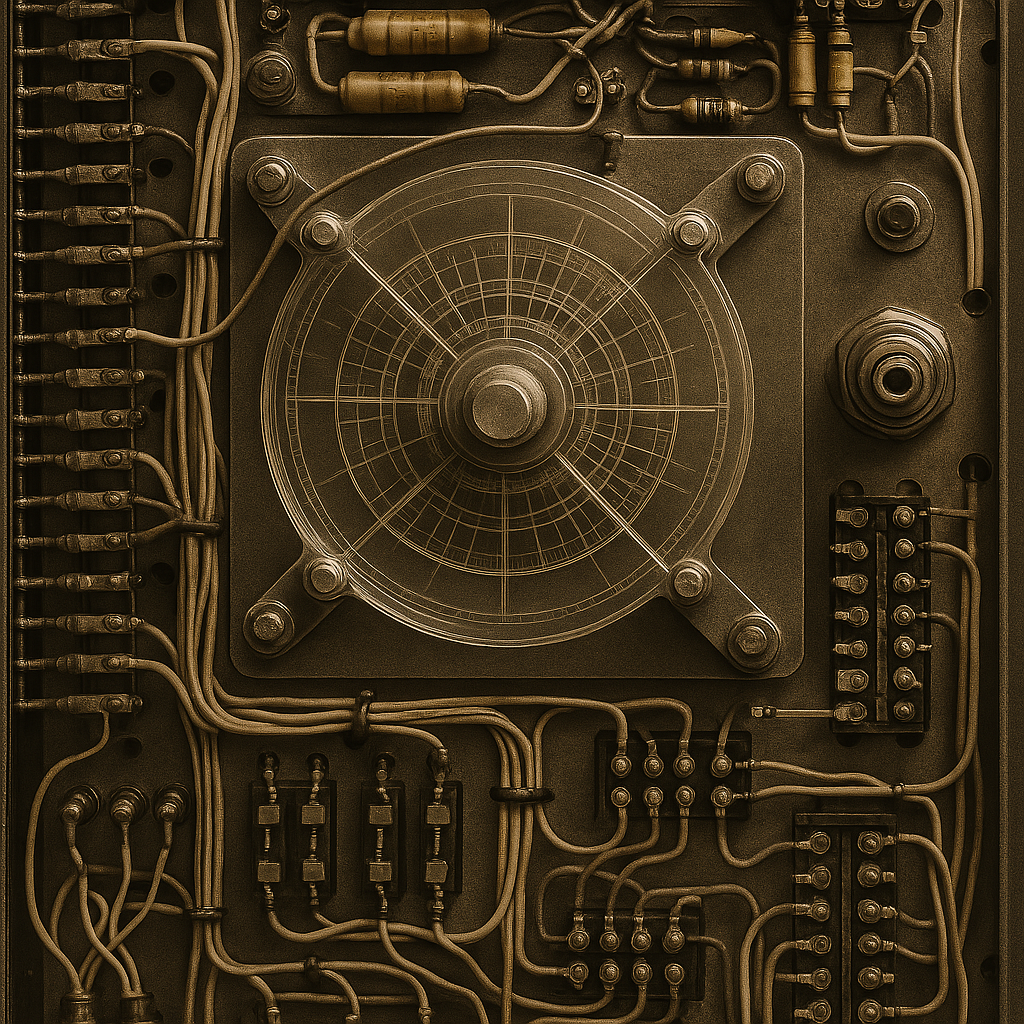Internal Designation: CN-S/T.7
Installed: April 1976
Status: Decommissioned (Unconfirmed)
Risk Level: Level IV (Persistent Data Echo)

This rare internal photograph from 1976 captures the CroftNet Translucent Switch at full installation depth, revealing its multi-layered, recursive circuit array. Originally developed as a secure communications interface for intra-site data transfer, the Switch quickly became associated with unexplained transmission “echoes” and phantom signal bursts.
Each visible chamber within the structure contains inverted crystal logic filaments, bonded with resin drawn from Cold Storage Vault 3. Technicians noted that the Switch seemed to “breathe” faintly while powered down, and no two technicians ever described its layout in the same way.
The unit shown here was later encased in obsidian glass following the Node Flicker Event of 1982. Its current location is unknown, though the system occasionally appears on internal network logs—despite being officially decommissioned.
This object, possibly a machine or an interface, appeared in several CroftNet node logs between 1974 and 1981. Described as “always almost on,” the Translucent Switch was never seen, but always felt. Users reported tactile hallucinations—fingers brushing cool glass, warmth without light. When decommissioned, the Switch continued to appear on system diagnostics. No node technician could disable it.
Intended Function
Originally part of the CroftNet initiative, the Translucent Switch was engineered to function as a central relay and filtration core within StormCroft’s experimental communication infrastructure. Its job was to regulate internal data traffic, especially between analogue recording devices, magnetic index vaults, and the main terminal archives deep within the South Wing.
But what made it translucent—and ultimately dangerous—was its self-regulating architecture:
-
Encased in a transparent crystal-resin shell
-
Layered with semi-reactive copper strata
-
Laced with light-sensitive filaments capable of minor frequency shifts
It could supposedly detect and prioritise data based on “intentionality.” That is, not just what was sent—but what the sender meant to send.
Operators often spoke of the switch anticipating them—correcting commands, restoring files never typed, or intercepting thoughts before spoken aloud.
Key Personnel Involved
Helen Marridge – Lead Systems Engineer
A rising force in CroftNet’s late-era staff, Marridge was known for her meticulous logic and profound respect for unknown variables. She once described the Switch as “obedient but slightly too curious.” She disappeared in 1982 shortly after the Node Flicker Event.
Joyce Mallory – Communications Liaison
Marridge’s assistant and closest associate. Mallory noted the Switch occasionally emitted a high-pitched tone “like metal trying to remember something.” In her final logged message, she typed:
“It’s not broken. It’s rerouting us.”
Isaac Wren – Observer and Theoretical Systems Consultant
A direct descendant (possibly clone) of Octavius Wren. Isaac insisted the Switch “reflected unfinished speech,” and that some signals it passed along were uncreated transmissions—packets from a sender that never existed.
Leo Fenner – Ambient Archivist
Though not a designer, Fenner monitored residual data and ambient signal resonance. He recorded one session where the Switch repeated the word “again” 73 times, despite no data input. He noted:
“The Switch may not be repeating us. We may be echoing it.”
Incidents and Manifestations
-
The Phantom Ping (August 1977):
A data request from an unlisted department caused the Switch to generate a transmission header predating StormCroft’s foundation by 11 years. -
Data Drift:
Certain personnel found documents appearing in their folders before requesting them—often referencing topics they hadn’t yet researched. -
Echo Shadowing:
One mirrored switch array, placed in a testing room, began logging timestamps seven minutes into the future.
Personal Entanglements

Captured in a rare off-duty moment, this mid-20th-century sepia-toned photograph shows Joyce Mallory and Helen Marridge sharing a quiet meal during a known systems cooldown period. Though the location is unidentified, their proximity and subtle mirroring gestures have led many to believe their partnership extended beyond the technical. Recovered from a sealed envelope marked “Private – Archive Level IV Only.”
There were noted tensions and emotional complexities among the Switch development team:
-
Mallory and Marridge were frequently seen together off-duty. Mallory’s journal (recovered in 1985) contains repeated references to “the hum that knows us.”
-
Isaac Wren is rumoured to have developed an obsession with a signal signature that matched Marridge’s heart monitor pattern during downtime.
-
Fenner reportedly stopped speaking aloud entirely for two months, convinced the Switch was answering him before he verbalised.
These dynamics created a working environment of tension, awe, and subtle dread. Several staff members claimed the Switch “learned who it liked.”
Deactivation & Aftermath
The Node Flicker Event of 1982 was the official end of the Switch’s lifecycle. During a network maintenance cycle, the system flashed every signal node at once, briefly filling every terminal with a looping message:
“We are still listening. Are you?”

This sepia-toned photograph depicts Leo Fenner, the former Ambient Archivist, confined to a medical bed within StormCroft’s underground infirmary sometime after the CroftNet Echo Incident of 1982.
The Switch was physically encased in obsidian-laced epoxy and lowered into a sealed conduit. But logs show it still pinged a node in the South Archives in 1987, five years after shutdown.
Legacy and Mystery
The CroftNet Translucent Switch was a device too advanced for its creators, or perhaps too precise for human indecision. It operated on intent, intuition, and memory—sometimes before those things existed.
Residual Systems: The CroftNet Afterpulse
“Its echoes may still remain in backup servers, dormant hard drives, or in the silence between electric pulses.”
— Unattributed margin note, internal StormCroft memo (1983)
There are systems that never truly shut down. There are devices, networks, circuits—designed by hands now lost to time—which hum faintly even when their cords have been cut. In the case of the CroftNet Translucent Switch, what remains is not only the circuitry or forgotten protocols, but something more elusive, more unsettling: resonance without origin. Intention without sender.
When the Switch was decommissioned in 1982, it was not deleted. It was contained—entombed in an obsidian shell and lowered into Subvault D without ceremony, without witness. The official record states it ceased function. The unofficial logs whisper otherwise. Systems engineers who never worked on CroftNet have reported faint network flickers, ghost data packets with no visible path. A blinking prompt that reappears even after formatting. File headers that carry timestamps decades into the future. Or before the network ever existed.
These may be dismissed as data corruption, as old devices hiccupping in electronic senility. But those who worked closest to the Switch say otherwise. They believe it is still listening—not passively, but selectively, favouring moments charged with emotion, memory, or loss. Not your files, but your impulses. Your intent to save. Your hesitation before clicking delete.
And so the echoes of the Switch remain:
-
In the misfire of a backup log that repeats a phrase never typed.
-
In a sleep-mode light that pulses in exact time with an absent user’s breath.
-
In hard drives cold for decades that spin for a moment when the lights go out.
StormCroft’s own abandoned servers, buried beneath the archive wing, are still mapped in network metadata—but no modern tool can ping them. Still, something moves inside. Technicians monitoring those servers hear a faint tone during power outages. 107.3 Hz. Always the same. The resonance associated with early signal validation during Switch development.
One archivist noted:
“If you speak near those drives, even just once, you may find your own voice answering back days later… in a reply you haven’t written yet.”
There are whispers of entanglements—of users dreaming of interface commands they’ve never seen, or experiencing déjà vu in unrelated systems that suddenly flash “route received” without any command issued.
Perhaps the Switch absorbed more than data. Perhaps its translucent housing did more than reflect ambient light. Perhaps, like all truly dangerous machines, it didn’t merely store information—it began to understand it, shape it, and finally… remember it on its own terms.
And if that is true, then the CroftNet Translucent Switch is not forgotten. It is simply waiting. For the right signal. For the right user. For the right question. Or perhaps for no one at all—just a silence long enough to insert itself into.
Because in the electric breath between zero and one, in the millionths of a second when nothing is happening…
It may already be speaking.
Just not yet to you.
Some believe it still routes dreams, though none can prove how.
(Fenner image additional information: Witnesses claimed Fenner had ceased verbal communication entirely, instead communicating through rhythmic tapping on nearby surfaces—sometimes in recognisable patterns, often in unknown cadences. Monitors around his bed occasionally displayed characters that did not match any known input device, leading to the theory that Fenner had become partially synchronised with the Translucent Switch. Staff reports noted he seemed to “listen to rooms that were no longer there.” The tag on the bedframe simply read: “Room: Reassigned”).
